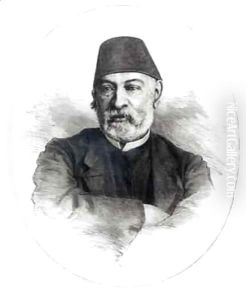Etienne Gabriel Bocourt Paintings
Étienne Gabriel Bocourt was a French painter, born in 1817 in Paris, who made significant contributions to 19th-century art, particularly within the genre of Orientalism and historical scenes. He was part of a wave of French artists who were captivated by the allure of the East, which was a popular theme due to the expansion of travel and imperialism during this era. Bocourt's career spanned a period of intense cultural and artistic development in France, coinciding with the Second Empire and the early years of the Third Republic.
Bocourt initially trained under the guidance of his brother, Félix Joseph Barrias, a notable painter in his own right, and later, he refined his skills at the École des Beaux-Arts in Paris. His education and early exposure to the arts profoundly influenced his stylistic development, leading him to adopt a meticulous approach to detail and composition, which became hallmarks of his work. Throughout his career, Bocourt exhibited at the prestigious Paris Salon, a testament to his recognition and success within the art community of his time. His works often depicted scenes inspired by his travels in North Africa and the Middle East, imbuing his paintings with a sense of exoticism and adventure that appealed to European audiences.
Despite the popularity of Orientalist themes, Bocourt’s oeuvre was not limited to this genre alone. He also painted historical subjects, landscapes, and portraits, showcasing his versatility as an artist. His historical paintings, in particular, were noted for their accuracy and attention to detail, reflecting his deep respect for the past and its narratives. Bocourt's landscapes and portraits, meanwhile, reveal a keen observation of nature and human character, rendered with a sensitivity that underscores his skill in capturing the essence of his subjects.
Étienne Gabriel Bocourt's contributions to French art were recognized in his time, and today, his works can be found in several museums and private collections. Despite facing the challenges of a rapidly changing art world at the turn of the century, Bocourt remained committed to his artistic vision, leaving behind a body of work that continues to be admired for its beauty, technical skill, and historical significance. He passed away in 1909, leaving a legacy that endures as a testament to his lifelong dedication to the arts.
